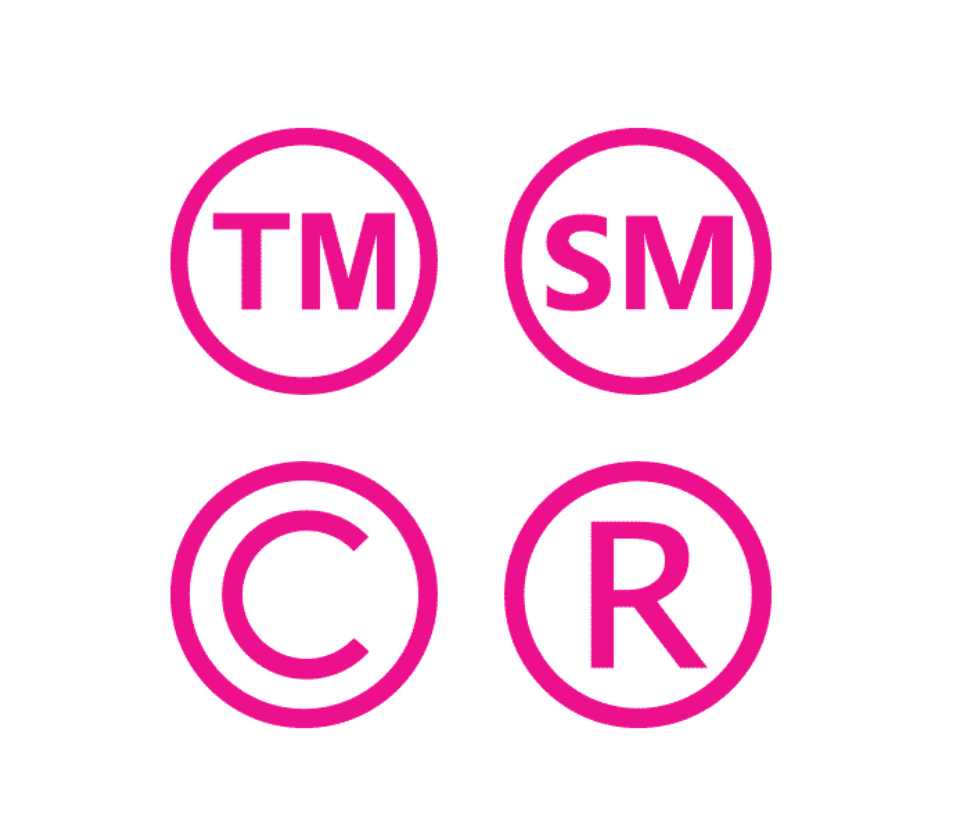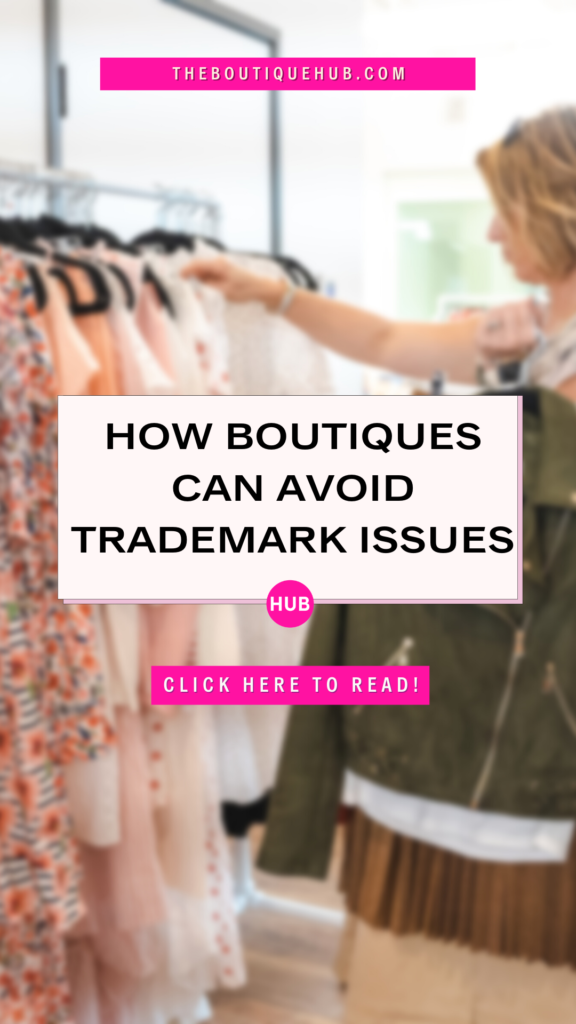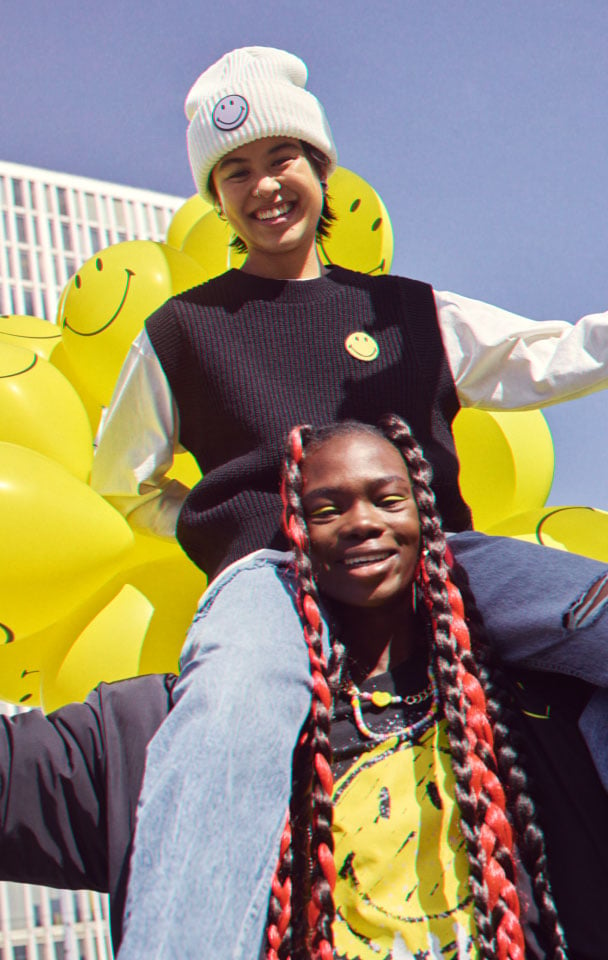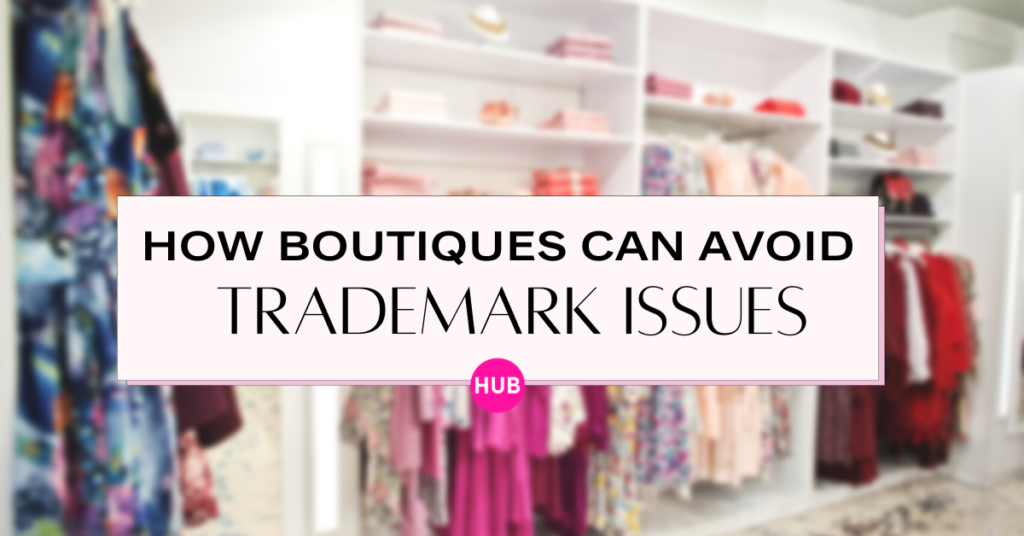The term trademark might send chills down your spine, but we’re here to simplify this idea for boutique owners. Let’s get into how boutiques can avoid trademark issues.
Starting off with the basics. What exactly is a trademark? A trademark is a type of intellectual property that legally protects your business at a federal level.
What can you trademark? Pretty much anything! From the name of a product, business, a catchphrase to logos, etc. Anything you want to protect you can trademark.
When should I consider trademarking? NOW! If you wait to start the process when you encounter an issue, you will end up spending more money in the long run.
What To Do Before Trademarking Anything
- Make sure the trademark isn’t taken – use Legalzoom or the US Patent and Trademark Office website to verify that the name is available
- Register your domain name
- Consult the legal counsel to know your rights and make sure you are fully protected
- Be aware of the three trademark symbols:
- R w/ a circle = used w/ USPTO Registered Trademarks
- TM = Used w/ trademarks not yet registered
- SM = Used w/ Service marks not yet registered

- Copyright is made for protecting the creator’s rights vs: Trademarks are there to prevent confusion in the marketplace. Trademarks cover business & product names, slogans, and other items used to identify brands in the marketplace.
- Know where to use your trademark: Everywhere and anywhere.
- Understand what a trademark does NOT protect: Anything generic
Things to Keep in Mind Before Trademarking
- Make sure you have it right – once you get something trademarked it is very hard and expensive to change it
- Make it unique – this helps with differentiating your product and services from the competition
- Be in it for the long haul – trademarks for good for the lifetime of a product/business. As long as the proper documents can be presented a trademark is viable
- Why would my trademark be rejected:
- Too generic – Being generic with your logo and the brand name makes it hard for clients to distinguish it, so it won’t be accepted as a trademark
- Confusing – Your logo resembles another brand and causes confusion to customers
- Just Pretty – Having a logo that’s simply intricate and ornamental rather than one that represents your brand values
- Offensive – Including images, symbols, or insulting words
- Misleading – Having parts of your logo or verbiage mislead the watcher about your brand location

Trademark FAQ’s
What is a trademark?
A trademark is the unique mark of a person, business, product, or service that can be legally protected when registered. Trademarks are usually registered to a specific “class,” meaning that the same trademark can be used by another business with an unrelated service or product.
Do you copyright or trademark a logo?
Copyrighting pertains to more creative or art-related products, such as television shows, films, or other creative endeavors. While trademarks are typically more limited to products and services and required to fall within a certain class based on usage, logos can be copyrighted or trademarked, based on use.
What are things you cannot trademark?
Anything generic, misleading, offensive, or without brand representation can be rejected as a trademark. Trademark infringement can lead to serious legal repercussions, so we’d suggest you hire a brand designer that understands the requirements thoroughly.
How much does it cost to trademark a logo in the US?
TEAS (Trademark Electronic Application System) handles most trademarking in the US. Under TEAS Plus (which has more paperwork upfront), the charge is $250 per class of goods/services. The charge for TEAS Standard (a filing option that has fewer upfront requirements) is $350 per class of goods/services.
What is a product-related trademark?
Registered trademarks fall under the ‘®’ category and can be backed up legally. Product-related trademarks are typically categorized under ‘™’ and fall under the purview of any item that can be sold or purchased. That said, service-related trademarks or ‘sm’ fall under the service category.
How do you trademark a name or design?
When ready to apply, go to the Trademark Electronic Application System (TEAS) of the USPTO and submit the necessary documentation along with information on the owner, the trademark type, the logo/drawing, its category (product or service), and the registration fees.
What are the benefits of using a trademark?
Using a Trademark shows you are serious about investing in your business, legally protects your name, creates your own identity, and makes your brands memorable.
How To Avoid Buying Counterfeit or Trademark Infringed Wholesale
Counterfeit wholesale or wholesale that infringes on trademarks can be an issue in the boutique world. Luckily, there are a few simple things to keep in mind that can help you avoid this issue.
Does the brand have an official license for the trademark in question?
Just because something is popular, does not mean it is up for public use. Common instances in the boutique world include the popular smiley face or band tees. These are all trademarked intellectual property that requires an official license to be legally used. When in doubt, ask!

Is it strikingly similar to something that is already trademarked?
Similarity is trademark infringement. In terms of the smiley face we have been seeing everywhere – just because it is not the exact same as the trademarked smiley face does not mean you are in the clear.
Understand Counterfeiting
Whereas trademark infringement uses similar-looking marks that are likely to cause confusion, counterfeiting is the unauthorized act of copying an exact image of the material.
Counterfeiting is different from trade infringement because the former intends to duplicate the product and its designs. For example, fake Louis Vuitton duffle bags and iPhone imitations. A trademark infringement is where one copies just a component of the product, which is primarily logos. Counterfeiting is against the law. Doing so may result in fines of up to $10,000 dollars and be sentenced for up to three and a half years.
Understanding Trademark Infringement
Trademark infringement is the unauthorized use of a trademark that will likely cause confusion about the source of the products and goods. If another brand uses a registered trademark, consumers will doubt the authenticity of the products. They will ask: Do the products come from our trusted brands, or we’re getting similar-looking packaging from a different company?
We hope you loved our article on How Boutiques Can Avoid Trademark Issues.
How else can The Boutique Hub help you grow? Get more information on growing your business by joining The Boutique Hub where we have tons of training, information, and most importantly, connection! www.theboutiquehub.com/join
Try out our service for a month, cancel anytime. Follow along on Instagram @theboutiquehub!

